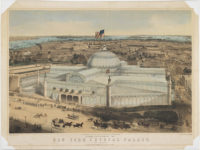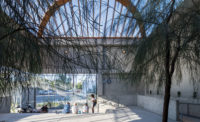Santiago, Chile
Jos' Cruz Ovalle and Partners
From its perch in the foothills of the Andes, the new graduate center on the Peñalolén campus of Adolfo Ibáñez University overlooks Chile’s capital city of Santiago. The rugged and steeply sloping terrain, and the majestic mountains, quite naturally provided the architect, Santiago-based José Cruz Ovalle, with his inspiration.
“The site indicated the way to approach the exterior,” explains Cruz, who conceived the reinforced-concrete building as several sculptural volumes emerging from a series of terraced patios. Ramps unfurl like ribbons from the sinuous, stuccoed exterior walls, providing paths from the terraces to the interior. On the upper levels, bridgelike portions of the building connect the various volumes, framing views of both the mountains and the city.
The 118,000-square-foot building is the latest addition to the 55-year-old, private university’s newest campus (the school also has another Santiago-area campus and two more locations in the coastal province of Valparaiso). Development at Peñalolén, about 6 miles to the east of downtown Santiago, began in 2000 with the construction of an undergraduate center and athletic facilities, followed by an auditorium, all designed by Cruz and completed in 2005.
The graduate center, which opened in the spring of 2007, is just over half a mile to the east of the earlier buildings and at a slightly higher elevation. It sits on a curved slope that projects from two flanking depressions populated with acacia trees. Inside, the programmatic components, which include lecture halls, a library, and faculty offices, are arranged around a multilevel skylit atrium and are connected with curving and crisscrossing ramps.
The soft plastered surfaces of the suspended circulation network can be appreciated as sculptural elements, Cruz points out. In addition, the multiple routes provide occupants with choices and foster chance encounters between faculty and students. In the graduate center, as in nature, “there are many ways to travel from one point to another,” says the architect, describing the atrium as a “continuous space” that is “never homogeneous.” The paths that run through it have “twists, turns, and size variations,” and lead occupants from dimly lit spaces to more brightly illuminated ones.




